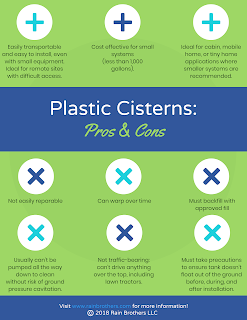USING A PUMP FOR DRIP IRRIGATION: COMMON MISTAKES AND BEST SOLUTIONS
One of our most frequently asked questions is, “Can I use your cistern pumps with my drip irrigation system?”
The answer to this question can get a bit tricky because drip irrigation itself is a confusing subject. Three types of irrigation systems get lumped into the “drip irrigation”category, so to answer this question, first we need to know what type of drip system is being used.
DRIP TAPE
First, there is drip tape -- an inexpensive (and usually disposable) flat plastic tape that is designed to work at 10 PSI maximum. Often times, a 10 PSI pressure regulator is required to run drip tape, or else the entire irrigation system is liable to blow apart. 10 PSI is low pressure. In fact, it is much lower than the majority of pumps are able to handle. Every pump has an operating range associated with it —also known as a pump performance curve. It’s a curve because flow (measured in gallons per minute) and pressure (measured in pounds per square inch) are directly related in a pump’s performance. As you increase your demand for flow, you decrease the pump’s ability to build pressure. Likewise, the reverse is true: As you demand an increase in pressure, you decrease your flow rate. For example, our Grundfos SBA 3-45-AW will operate at 52 PSI when the flow being demanded is 5 gallons per minute, and it will operate at 38 PSI when we call for 10 GPM. When we follow the pump’s curve, we see that at 10 PSI (which, again, is the operating pressure for drip tape), the Grundfos SBA will produce a flow rate of 23 gallons per minute! It takes a LOT of drip tape to get to that kind of flow rate.
So what are the options? Can you use a pump with drip tape systems?
Yes and no.
If you stick a Grundfos SBA or a Strom BSP automatic pump in a tank and run it to your drip system, chances are good that you’re going to cause that pump to short cycle constantly…it will detect a flow being demanded by your irrigation system, but, without sufficient flow rates (in this case, 23 gallons per minute), it will be able to build up so quickly to the 10PSI pressure that it will shut off immediately. That’s a quick way to burn up a pump.
There is a solution, though. A traditional drip irrigation system will be set up, in order of flow, as Pump —> Valve (automatic or manual) —> 10 PSI Pressure Regulator —> Drip Tape. If you know you aren’t going to have enough flow being demanded from your drip tape system, the simple solution is to install a “T”fitting after your valve but before your pressure regulator and run a 1/2”or 3/4”or 1”return line back to your water tank. In so doing, you will create a relief port for excess pressure and excess flow generated by the pump, causing it to run less frequently. And, if you bring your return line right into the top of your water tank, you have the added benefit of circulating the water and reducing the likelihood of algae growth.
DRIP EMITTERS
The second type of drip irrigation system is one that uses drip emitters. Like drip tape, drip emitters typically require low pressure, and they always drastically reduce flow. Unless you are using hundreds of emitters at once, it is not recommended to use a pump to provide water to drip emitters. Instead, we recommend using zero-pressure emitters, such as Flag Emitters, where the pressure created by gravity on an above ground tank is sufficient to provide water to the emitters.
DRIP TUBING
The third and final type of drip irrigation system is drip tubing. Drip tubing is round and generally has drip emitters embedded every 8-24”. Unlike drip tape, drip tubing can work under pressure…generally as high as 50-60 PSI. Drip tubing works well with our cistern pumps, though, again, you will want to reference the pump’s performance curve to see how much flow you should have in your irrigation system at a given pressure. For instance, if you want to run the Grundfos SBA pump at 50PSI, you need to make sure that you zone out your irrigation system so that each zone is operating at 8 GPM.
Each drip tubing roll will specify the spacing of the emitters and the flow rate of each emitter, so if you are using tubing that has emitters every 12”, and the emitters have a flow rate of 0.5 gallon per hour (tubing is usually measured in gallons per hour, not gallons per minute) per emitter, then you would 960 feet of drip tubing to get a flow rate of 8 gallons per minute and to stay within the operating capacity of the SBA pump. If you don’t need that much drip tubing, then, again, we recommend installing a return line back to your rain tank that can let water freely flow into your tank to bleed off excess pressure/flow.

